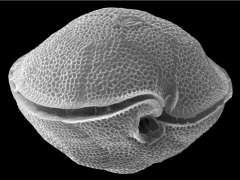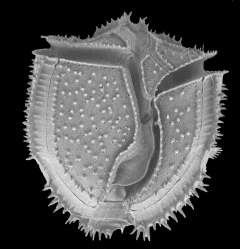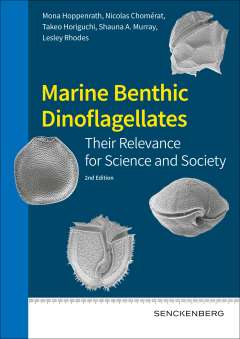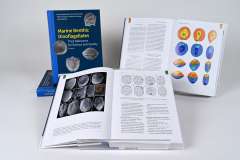Underestimated Hazard and Resource at the Bottom of the Sea
New dinoflagellate identification guide highlights the importance of marine single-celled organisms for science and society
Today, marine biologist Dr. Mona Hoppenrath from Senckenberg am Meer in Wilhelmshaven, together with international colleagues, presents the second, expanded edition of the world’s most comprehensive identification guide for marine benthic dinoflagellates: “Marine Benthic Dinoflagellates – Their Relevance for Science and Society.” In addition to describing numerous new species, for the first time also on the basis of molecular genetic data, the book categorizes the global dangers posed by the often toxic single-celled organisms – but also their benefits for science and as potential suppliers of nutrients and energy.
The microscopic dinoflagellates are barely known to the general public, yet they have a considerable impact on nature and humans. Widespread in salt and fresh water throughout the world, the tiny single-celled organisms play an important role in aquatic food webs – most species as part of the plankton, and the benthic ones in sediments on the sea floor or epiphytic on algae, seagrass, or corals. “Some species produce toxins that can cause serious poisoning in humans and are also harmful to other marine organisms,” explains Dr. Mona Hoppenrath, a scientist at Senckenberg am Meer in Wilhelmshaven and the book’s first author. “Through the consumption of fish and other seafood, for example, toxins from Gambierdiscus species that have accumulated in the food chain can trigger the ciguatera disease, one of the most common types of fish poisoning.” And in the 1990s, an algal bloom of the genus Ostreopsis caused hundreds of vacationers on the Ligurian coast to be hospitalized. “As a result of climate change, such cases are likely to occur with increasing frequency,” adds Hoppenrath.
The new volume impressively illustrates the species richness of these marine single-celled organisms, with its largest section devoted to the taxonomy of benthic dinoflagellates in their astonishing diversity of forms. 242 species in 63 genera are presented in detail, illustrated with more than 240 color illustrations, about 250 electron micrographs, and more than 330 drawings. Since its predecessor volume, “Marine Benthic Dinoflagellates – Unveiling their Worldwide Biodiversity,” 64 new species, 20 new genera, and 19 new combinations – i.e., newly named taxa – have been added. “At the same time, we are certainly only revealing the ‘tip of the iceberg,’” says Hoppenrath. “We can assume that in addition to the approximately 2,500 known living dinoflagellate species, many more exist that have not yet been described!” Parallel to the new edition, identification aids and matrix keys for genus and species identification will be available via the website of the “Centre of Excellence for Dinophyte Taxonomy” (CEDiT) at www.dinophyta.org/identification-keys.
A new addition is a chapter on the relevance of dinoflagellates for science and society, which highlights the dangers posed by the single-celled organisms, but also their potential benefits. “For example, we have known since the 1970s that certain species of the genus Gambierdiscus can cause life-threatening ciguatera poisoning through the consumption of certain tropical and subtropical fish and seafood. Many coastal countries have subsequently introduced monitoring programs. Worldwide, approximately 20,000 to 60,000 cases are registered annually,” Hoppenrath reports. “At the same time, the number of unreported cases is high: It is estimated that almost 16,000 poisonings occur each year in the U.S. alone – quite possibly, only 10 percent of cases worldwide are reported to the health authorities.” Ongoing climate change appears to be exacerbating the problem, with coral bleaching due to rising ocean temperatures and other degradation of coral ecosystems apparently causing an increased abundance of Gambierdiscus, leading the Intergovernmental Panel on Climate Change to predict that the number of ciguatera poisonings will continue to rise. At the same time, there are indications that Gambierdiscus has now spread to temperate regions as well.
In addition to health hazards, the toxic single-celled organisms also cause considerable economic damage. In the USA, ciguatera incurs an estimated 17 million U.S. dollars in health care expenses per year. Import bans on reef fish as a result of reported poisonings particularly affect small tropical and subtropical island states that are heavily dependent on fisheries.
On the other hand, dinoflagellates can also be a useful resource for humans, for example as suppliers of important unsaturated fatty acids for a balanced diet. “The planktonic species Crypthecodinium cohnii has already been used in the industrial production of omega-3 fatty acid as a dietary supplement,” explains Hoppenrath. “For the most part, however, the possibilities for industrial use of benthic dinoflagellates that produce omega-3 fatty acids in significant quantities are still largely unexplored – there is great potential here.” Biofuels could also potentially be derived from certain species. And in medical research, certain toxic compounds have shown promise for the development of therapeutic agents, for example, in cancer therapy.
“Last but not least, and quite surprisingly, benthic dinoflagellates have proven to be very useful and important in natural science for basic evolutionary research – for example, in the study of photosynthesis and various processes in cell nuclei. They are fascinating creatures that we need to explore further for many reasons!” concludes Hoppenrath.
Publication:
Mona Hoppenrath, Nicolas Chomérat, Takeo Horiguchi, Shauna A. Murray & Lesley Rhodes: Marine Benthic Dinoflagellates – Their Relevance for Science and Society, 2023, 376 pages, 122 figs., 8 tables, 17 x 24 cm, hardcover, ISBN 978-3- 510-61424-0, Senckenberg-Buch 88, 2nd, completely revised edition, 34.90 Euro, www.schweizerbart.de/9783510614240
Press copies may be ordered at pressestelle@senckenberg.de!







